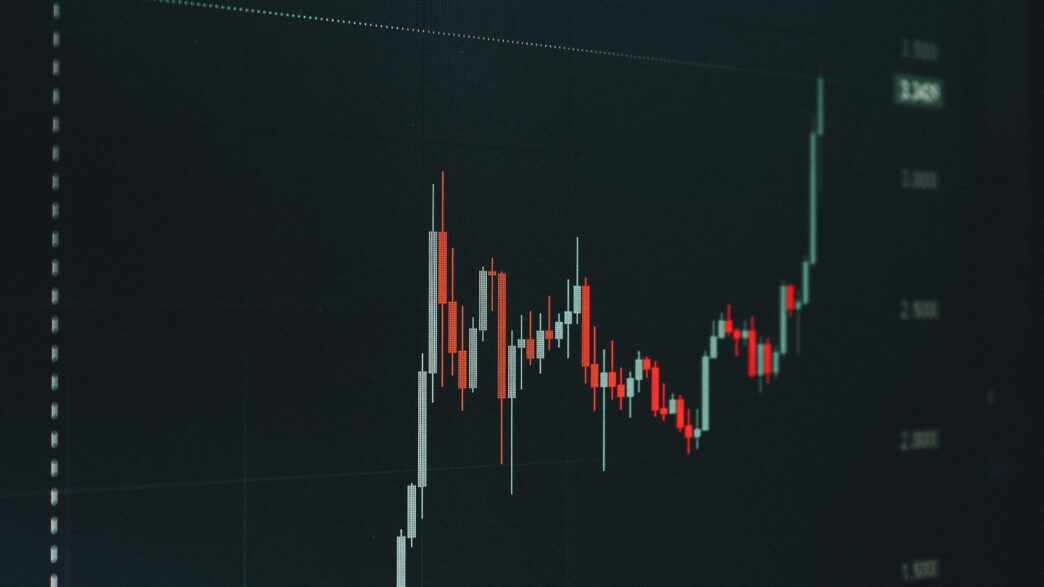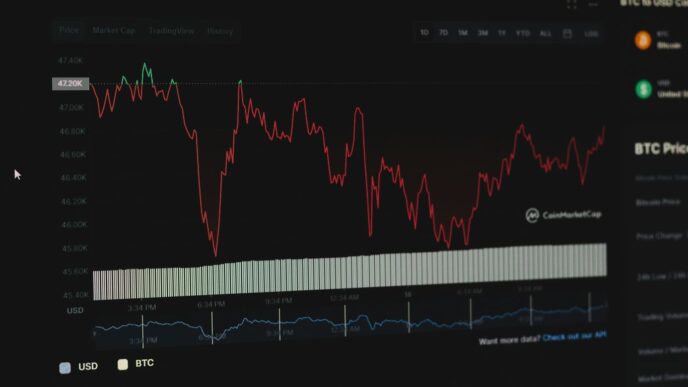Lately, the crypto world has been a bit wild, right? Prices are jumping around like crazy, and it can feel like a real rollercoaster. If you’re invested in digital coins, you’ve probably seen some big swings. This post is here to break down why these crypto crash events happen, what we can learn from the past, and most importantly, how you can keep your cool and your investments steady when things get bumpy.
Key Takeaways
- A crypto crash is a sudden, sharp drop in the prices of digital assets, often driven by a mix of speculation, regulatory news, or broader economic shifts.
- Looking back at past crypto crashes shows us that while painful, these events are often followed by periods of recovery, highlighting the market’s cyclical nature.
- Having a solid investment plan, including diversification and clear entry/exit points, is key to managing risk during market downturns.
- Avoid making impulsive decisions like panic selling; instead, consider strategies like dollar-cost averaging and focusing on your long-term goals.
- Building emotional resilience by managing fear and anxiety, making rational choices, and having a support system can help you navigate the ups and downs of the crypto market.
Understanding The Crypto Crash Phenomenon
What Constitutes A Cryptocurrency Crash?
So, what exactly is a crypto crash? Basically, it’s when the prices of digital currencies, like Bitcoin or Ethereum, take a nosedive, and I mean a big one, really fast. It’s not just a small dip; we’re talking about significant drops in value across the board, often wiping out billions in market capitalization in a matter of hours or days. It feels like the whole market is suddenly on a trapdoor, and everyone’s scrambling to get out.
The Volatile Nature Of Digital Assets
Look, cryptocurrencies are known for being a bit wild. They’re not like stocks or bonds that tend to move more slowly. Crypto prices can swing wildly because the market is still pretty new and a lot of people are still figuring it out. Plus, things like social media buzz or a single influential person’s tweet can send prices soaring or plummeting. It’s this inherent choppiness that makes them so exciting for some, but also so nerve-wracking for others.
Factors Fueling Market Downturns
What makes these crashes happen? It’s usually a mix of things. Sometimes, it’s big news, like governments talking about new rules or regulations that make investors nervous. Other times, it’s just pure speculation – people buying something because they think the price will go up, creating a bubble that eventually pops. We’ve also seen major drops happen because of technical glitches or security breaches that shake people’s confidence. It’s a complex ecosystem, and a lot can influence where prices go.
Here are some common triggers:
- Regulatory Uncertainty: When governments are unclear about how they’ll treat crypto, it creates a lot of doubt.
- Market Sentiment Shifts: News cycles, influencer opinions, and general public mood can drastically affect how people feel about crypto.
- Economic Headwinds: Broader economic issues, like inflation or interest rate changes, can make investors pull back from riskier assets like crypto.
- Technological Setbacks: Major network issues or security flaws can erode trust in a specific coin or the market as a whole.
Historical Precedents Of Crypto Crashes
Looking back at what’s happened before can really help us understand what’s going on now with crypto. It’s not like this is the first time prices have taken a nosedive. We’ve seen this movie before, and knowing the plot can make the current scene less scary.
Lessons From Past Market Collapses
Remember the ICO boom and bust around 2017? So many projects popped up, promising the moon, and people threw money at them. Then, poof! Most of them vanished, taking investors’ cash with them. It was a big wake-up call about how much hype can drive prices way beyond what a project is actually worth. This kind of speculative frenzy often sets the stage for a sharp fall. We also saw the Mt. Gox hack back in 2014. That was a huge deal for Bitcoin, shaking everyone’s confidence when a major exchange got compromised. It showed us how vulnerable the whole system could be to security issues and bad actors.
Impact Of Regulatory Actions On Prices
Governments and financial watchdogs have a big say in how crypto prices move. When news breaks about potential new rules or bans in a major country, you can bet the market reacts. Think about times when certain nations have cracked down on crypto trading or mining; prices usually dip pretty hard in response. This uncertainty about future regulations can make investors nervous, leading them to sell off their holdings. It’s a constant dance between innovation and control, and regulatory actions often act as a major trigger for price drops. For instance, a sudden announcement about tariffs can ripple through markets, affecting even digital assets, as seen in past events where unexpected tariffs caused a crypto flash crash.
The Role Of Technological Setbacks
It’s not just about money and rules; the tech itself plays a part. When a major blockchain has a glitch, or a big exchange gets hacked, trust takes a hit. These aren’t just minor inconveniences; they can lead to significant price drops because people start questioning the reliability and security of the whole space. Sometimes, it’s a network failure, other times it’s a smart contract exploit. Whatever the technical issue, it often shakes investor confidence and can contribute to a broader market downturn. These events remind us that while the technology is groundbreaking, it’s still evolving and has its own set of risks.
Navigating A Crypto Crash With Strategy
Okay, so the crypto market’s doing its usual rollercoaster thing, and your portfolio is looking a bit… green. It happens. Instead of hitting the panic button, let’s talk about having a plan. Think of it like having a map before you go on a road trip – you wouldn’t just start driving and hope for the best, right? The same goes for your crypto investments.
Developing A Robust Investment Plan
First things first, you need a solid plan. This isn’t about guessing; it’s about setting clear goals and understanding your own risk tolerance. What are you trying to achieve with your crypto investments? Are you saving for a down payment in five years, or are you looking for long-term growth over decades? Your plan should reflect that. It’s also about knowing how much you can afford to lose without it messing up your life. A well-defined plan acts as your anchor when the market gets choppy. It helps you avoid making rash decisions based on fear or hype.
The Power Of Diversification
Putting all your eggs in one basket is a classic mistake, especially in crypto. Diversification means spreading your investment across different types of assets. This could mean not just different cryptocurrencies (like Bitcoin, Ethereum, and some smaller altcoins), but also other types of investments outside of crypto altogether. If one asset tanks, the others might hold steady or even go up, cushioning the blow. It’s a way to manage risk, similar to how institutional investors manage risk. You can look into hedging strategies for risk to get a better idea of how this works.
Here’s a simple way to think about it:
- Cryptocurrencies: Spread across different types (e.g., large-cap like BTC, mid-cap, promising smaller projects).
- Other Digital Assets: Maybe explore NFTs or DeFi tokens if you understand them.
- Traditional Assets: Consider stocks, bonds, or real estate outside of your crypto holdings.
Setting Clear Entry And Exit Points
This is where having a plan really pays off. Before you even buy a cryptocurrency, you should have an idea of when you might sell it. This isn’t about timing the market perfectly – that’s nearly impossible. It’s about having predetermined conditions for buying and selling. For example, you might decide to buy more if a certain coin drops to a specific price you think is a good deal, or sell a portion if it doubles in value. Having these points written down helps remove emotion from the equation. When prices are plummeting, it’s easy to sell everything in a panic. Conversely, when prices are soaring, it’s tempting to buy more at the peak. Clear exit points can help you lock in profits or cut losses before they become too severe.
Mitigating Losses During Market Volatility
Okay, so the crypto market is doing its usual rollercoaster thing, and your portfolio is looking a little… green. It happens. The big thing to remember is not to freak out. Making rash decisions when prices are dropping is usually the fastest way to turn a paper loss into a real one.
Avoiding Panic Selling
Look, I get it. Seeing your hard-earned money shrink on a screen is stressful. But selling everything the second prices dip is like throwing the baby out with the bathwater. Most of the time, these downturns are temporary. If you sell in a panic, you miss out on the eventual rebound. Think about it: you bought these assets for a reason, right? Unless that fundamental reason has changed drastically, holding on might be the smarter play. It’s tough, but try to step away from the charts for a bit if you feel the urge to hit that sell button.
Dollar-Cost Averaging For Stability
This is a strategy that can really help smooth out the ride. Instead of trying to time the market (which, let’s be honest, is nearly impossible), you invest a fixed amount of money at regular intervals. So, if Bitcoin is $50,000 this week, you buy $100 worth. If it drops to $40,000 next week, you still buy $100 worth. This means you buy more coins when the price is low and fewer when it’s high. Over time, this can lower your average cost per coin and reduce the impact of big price swings. It takes the emotion out of it because you’re just sticking to a plan.
Here’s a simple example:
| Investment Period | Amount Invested | Bitcoin Price | Coins Purchased |
|---|---|---|---|
| Month 1 | $100 | $50,000 | 0.002 |
| Month 2 | $100 | $40,000 | 0.0025 |
| Month 3 | $100 | $45,000 | 0.0022 |
| Total | $300 | N/A | 0.0067 |
Your average price per coin here is roughly $44,776, which is lower than if you had just bought $300 worth at $50,000.
Focusing On Long-Term Investment Goals
What were you trying to achieve when you first got into crypto? Was it to get rich quick, or was it to build wealth over several years? If it’s the latter, then these short-term dips are just bumps in the road. Keep your eye on the prize. Think about why you invested in the first place. Was it for the technology? The potential for future adoption? Reminding yourself of your original goals can help you stay grounded when the market gets shaky. It’s easy to get caught up in the day-to-day price action, but the real gains often come from sticking with a solid strategy for the long haul.
Cultivating Emotional Resilience In Crypto

Watching your crypto investments drop like a stone can really mess with your head. It’s easy to get caught up in the fear and anxiety, making rash decisions you’ll regret later. But honestly, staying calm when things get wild is just as important as having a solid investment plan. It’s about building up that mental toughness so you can think straight when everyone else is panicking.
Managing Fear And Anxiety During Downturns
When the market takes a nosedive, that knot in your stomach is real. You see red everywhere, and your first instinct might be to hit that sell button and run. But that’s usually the worst move. Instead, try to take a step back. Think about why you invested in the first place. Were you aiming for a quick buck, or do you believe in the long-term potential of these digital assets? Reminding yourself of your original goals can help ground you.
- Take a break from the charts: Staring at falling prices all day won’t help. Step away, go for a walk, do something completely unrelated to crypto.
- Limit your news intake: Constant updates about how bad things are can amplify your worries. Stick to reliable sources and avoid the endless doom-scrolling.
- Practice mindfulness: Simple breathing exercises or a quick meditation can help you feel more centered and less overwhelmed.
The Importance Of Rational Decision-Making
Fear is a powerful emotion, and it can cloud your judgment something fierce. When you’re scared, you’re more likely to make decisions based on emotion rather than logic. This often means selling at the bottom of a crash, locking in losses, or buying into hype without doing your homework. The goal is to make choices that align with your investment strategy, not with the latest panic on social media.
Here’s a quick way to check if you’re being rational:
- Pause: Before making any trade, stop and ask yourself why you’re doing it.
- Consult your plan: Does this move fit with your pre-defined strategy?
- Seek a second opinion (if possible): Talk to a trusted friend or mentor who understands crypto, but make the final call yourself.
Building A Supportive Investor Network
Going through a crypto crash alone can feel pretty isolating. It helps a lot to connect with other people who get what you’re going through. Finding a community, whether online or in person, where you can share experiences and get different perspectives can make a huge difference. Just remember to filter the advice you get – not everyone in a community is giving sound guidance. Look for people who are level-headed and focus on long-term strategies, not just get-rich-quick schemes. A good support system can be your anchor in the storm.
Identifying Triggers For A Crypto Crash

So, what actually sets off one of these wild crypto price drops? It’s rarely just one thing, but a mix of factors that can snowball pretty quickly. Think of it like a chain reaction – one event sparks another, and before you know it, prices are heading south.
Regulatory Concerns And Uncertainty
Governments and financial watchdogs around the world are still figuring out how to handle digital assets. When new rules are proposed, or existing ones are unclear, it creates a lot of uncertainty. Investors get nervous. Will their holdings be taxed heavily? Will certain coins be banned? This kind of doubt can lead people to sell off their crypto, pushing prices down. It’s like waiting for a storm when you don’t know how bad it will be – most people just want to get inside.
Market Speculation And Bubble Bursts
Sometimes, a cryptocurrency’s price can shoot up way faster than its actual usefulness or adoption would suggest. This is often driven by hype and people betting that the price will keep going up, not necessarily because of the technology itself. When this happens, you get what’s called a bubble. Eventually, the hype fades, or people decide to cash out their profits, and the bubble pops. This can lead to a really sharp and sudden drop in value. It’s a bit like a party getting too wild – eventually, someone has to turn off the music.
Economic Factors Influencing Crypto
Cryptocurrencies don’t exist in a vacuum. They’re affected by what’s happening in the broader economy. Things like inflation, interest rate changes by central banks, or even major global events can make investors rethink where they put their money. If the economy looks shaky, people might pull money out of riskier assets like crypto and move it into safer havens. For instance, a sudden increase in tariffs between major economies can shake up global markets, and crypto often gets caught in the crossfire, as seen in past events where trade tensions impacted digital assets.
Here are some common triggers:
- Sudden negative news: Think major hacks, large-scale scams, or even just rumors of regulatory crackdowns.
- Whale activity: When large holders of a cryptocurrency sell off a significant amount, it can trigger panic selling among smaller investors.
- Liquidity crises: In some cases, a lack of buyers when sellers are abundant can cause prices to plummet rapidly.
- Technological glitches: Major bugs or network failures can erode confidence in a project’s viability.
Strategies For Post-Crash Recovery
Okay, so the market took a nosedive. It happens. The good news is, a crash isn’t the end of the road for your crypto investments. It’s actually a chance to regroup and get smarter about what comes next. Think of it like a tough workout – it’s hard while you’re doing it, but it makes you stronger.
Identifying Opportunities In A Downturn
When prices are down, it might seem like everything is lost, but that’s not always the case. Sometimes, the best deals appear when everyone else is running for the exits. It’s about looking past the immediate panic and seeing potential.
- Look for solid projects: Not all cryptocurrencies are created equal. During a downturn, focus on projects with strong fundamentals, active development teams, and real-world use cases. These are the ones more likely to bounce back.
- Consider undervalued assets: A broad market crash can drag down even good projects. This might be your chance to pick up assets that were perhaps overvalued before, but now represent a better entry point.
- Research new trends: Downturns can sometimes signal shifts in the market. Keep an eye on emerging technologies or narratives that might gain traction as the market recovers.
Rebalancing Your Portfolio
After a big drop, your portfolio probably looks pretty different than it did before. Some assets might have shrunk more than others, throwing off your original plan. Rebalancing is like tidying up your investment house.
- Review your holdings: Take a good look at what you own and how much it’s worth now compared to your initial investment. See how the percentages have shifted.
- Adjust allocations: You might need to sell some assets that have held up relatively well to buy more of those that have fallen significantly but still have good prospects. This brings your portfolio back in line with your risk tolerance.
- Reassess risk: Has your overall risk level changed? Maybe you need to trim back on certain types of crypto or add more stable assets if your comfort level has decreased.
Staying Informed On Market Trends
It’s easy to want to tune out when things get rough, but now is precisely the time to pay attention. The crypto world moves fast, and understanding what’s happening can make a big difference in your recovery strategy. Keeping up with reliable news sources and analysis is key to making smart moves. This includes understanding regulatory changes, technological advancements, and broader economic factors that could influence the market. For instance, keeping an eye on how Bitcoin is performing can offer insights into the wider market’s direction, as it often leads the way for other digital assets. You can find more on strategies like dollar-cost averaging for safer exposure to Bitcoin following a downturn.
Wrapping It Up
Look, crypto crashes are part of the game. They’re not fun, and they can make you want to pull your hair out. But if you’ve been paying attention, you know they’re not the end of the world. By keeping a level head, not putting all your eggs in one basket, and remembering that markets go up and down, you can get through this. Stay informed, don’t make rash choices, and you’ll be in a much better spot when things start to turn around. It’s a wild ride, for sure, but with the right approach, you can handle it.
Frequently Asked Questions
What exactly is a cryptocurrency crash?
A crypto crash is when the prices of digital money, like Bitcoin or Ethereum, drop really fast and by a lot. Imagine a balloon that suddenly loses all its air – that’s kind of what happens to the value of these digital coins during a crash.
Why do crypto prices drop so suddenly?
Lots of things can cause crypto prices to fall quickly. Sometimes, big news about governments making new rules, or even just a lot of people getting scared and selling their coins at the same time, can make prices tumble. Also, sometimes people get too excited about a coin, its price goes way up, and then it falls back down just as fast.
Should I sell all my crypto when it starts crashing?
It’s tempting to sell when prices are dropping, but that’s often called ‘panic selling’ and can lead to losing money. It’s usually better to take a deep breath, think about why you invested in the first place, and consider if selling right away is the best move for your long-term goals.
What’s ‘dollar-cost averaging’ and how can it help?
Dollar-cost averaging means you invest a set amount of money into crypto on a regular schedule, like every week or month, no matter the price. This way, you buy more coins when prices are low and fewer when they’re high, which can help even out your average cost over time and reduce the impact of big price swings.
How can I avoid getting too worried during a crypto crash?
It’s normal to feel anxious when your investments drop. To stay calm, try to focus on your long-term plan instead of daily price changes. Talking to trusted friends who also invest, or taking breaks from looking at charts, can also help manage your feelings and make smarter choices.
Are crypto crashes a chance to buy more?
For some investors who believe in the long-term potential of certain cryptocurrencies, a crash can be seen as an opportunity to buy those assets at a lower price. However, this is a risky strategy and should only be considered after careful research and if you have a solid plan for holding the investment for an extended period.














